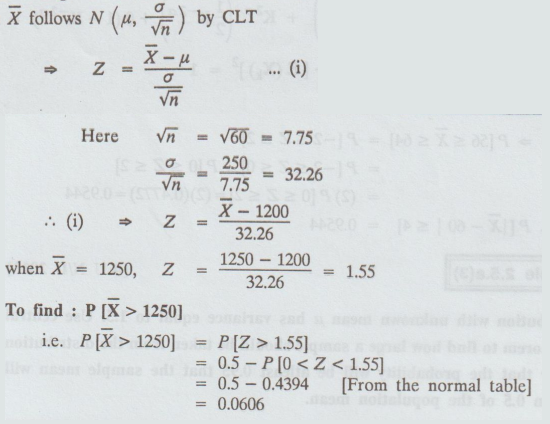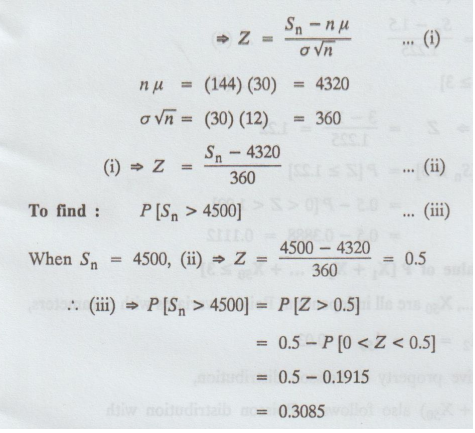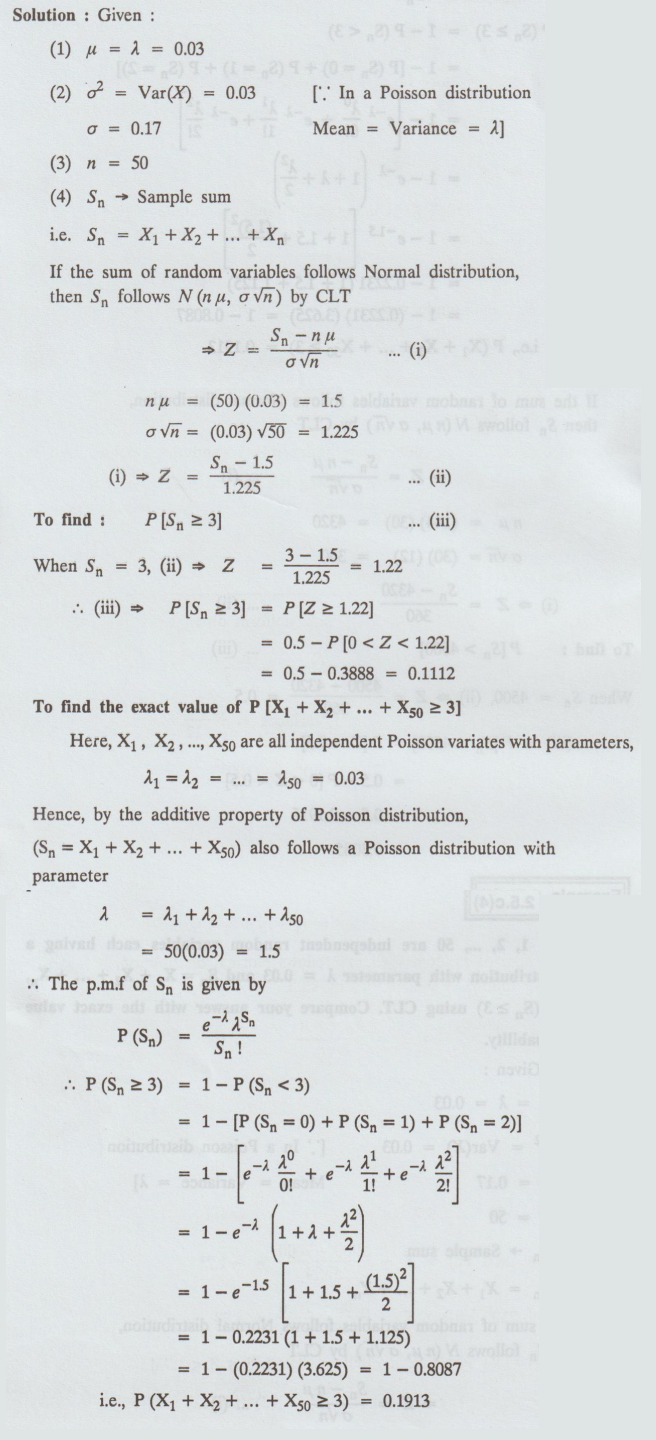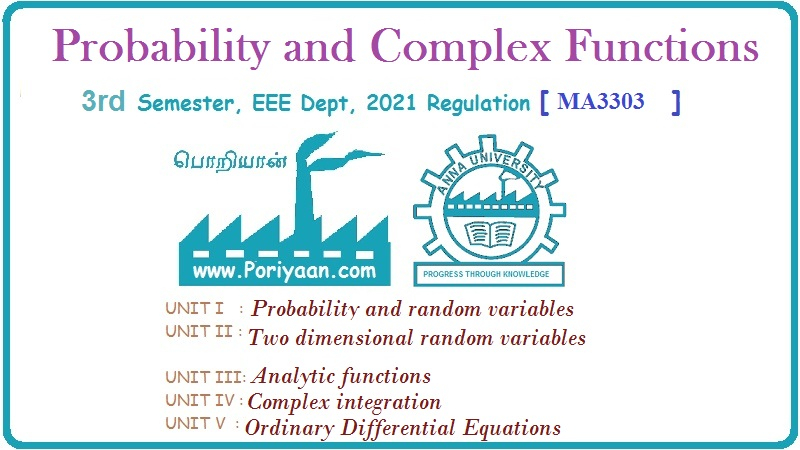Probability and complex function: Unit II: Two dimensional random variables
Central limit theorem: Example Solved Problems
Two dimensional random variables
Probability and complex function: Unit II: Two dimensional random variables : Examples
Example
2.5.a(1)
The
lifetime of a certain brand of an electric bulb may be considered as a RV with
mean 1200 h and standard deviation 250 h. Find the probability, using central
limit theorem, that the average lifetime of 60 bulbs exceeds 1250 h. or [AU N/D 2008] [AU N/D 2006] [A.U Trichy M/J 2011] [A.U N/D
2013]
[A.U
N/D 2018 R-17 PS]
Solution :
Given:
(1) μ = E [X] = 1200
(2)
σ = S. d. [X] = 250
(3)
n = 60
(4) ![]() = mean life time of 60
bulbs
= mean life time of 60
bulbs
If
the average of random variables follows Normal distribution, then

Example
2.5.a (2)
A
random sample of size 100 is taken from a population whose mean is 60 and the
variance is 400. Using CLT, with what probability can we assert that the mean
of the sample will not differ from μ = 60 by more than 4? [AU A/M 2003, Trichy
A/M 2010] [A.U A/M 2010]
Solution:
Given:

Example
2.5.a(3)
[A.U
N/D 2013]
A
distribution with unknown mean u has variance equal to 1.5. Use central limit
theorem to find how large a sample should be taken from the distribution in
order that the probability will be atleast 0.95 that the sample mean will be
within 0.5 of the population mean. [A.U. N/D 2004] [A.U A/M 2003]
Solution
:

TYPE
2.
If the discrete random variables follows normal distribution, then ![]() follows
N (µ, ɑ) by CLT.
follows
N (µ, ɑ) by CLT.

Example 2.5.b(1)
A
coin is tossed 10 times. What is the probability of getting 3 or 4 or 5 heads.
Use central limit theorem. [AU N/D 2009] [A.U CBT M/J 2010] [A.U N/D 2003]
Solution:
Given:

To
approximate the discrete probability distribution to continuous probability
distribution add 0.5 to the upperbound and subtract 0.5 from the lower bound.

Example
2.5.b (2)
A
coin is tossed 300 times found the probability that heads will appear more than
140 times and less than 150 times.
Solution:
Given:

TYPE
3. If
the sum of random variables follows Normal distribution, then Sn
follows N (n µ, σ√n) by CLT
⇒ Z = Sn – n
µ / σ√n
Example
2.5.c(1)
If
X1, X2 ... Xn are Poisson variates with
parameter λ = 2, use the central limit theorem to estimate P (120 ≤ Sn ≤ 160), where
Sn
= X1 + X2 + … + Xn and n = 75.
[AU
N/D 2009, N/D 2010] [A.U M/J 2012]
Solution:
Given:

If
the sum of random variables follows Normal distribution, then Sn follows N (n
µ, σ √n) by CLT

Example
2.5.c(2)
Let
X1, X2 …, X100 be independent and identically
distributed RVS with mean μ = 2 and σ2 = 1/4.
Find
P(192 < X1 + X2+ ... + X100 < 210)
[A.U
N/D 2012]
Solution:
Given:
(1)
µ = 2
(2)
σ2 = 1/4 ⇒ σ = 1/2
(3)
n = 100
(4)
Sn → Sample sum
i.e.
Sn = X1 + X2 + ... + X100
If
the sum of random variables follows Normal distribution, then Sn
follows N (nµ, σ√n) by CLT

Example 2.5.c(3)
The
burning time of a certain type of lamp is an exponential random variable with
mean 30 hrs. What is the probability that 144 of these lamps will provide a
total of more than 4500 hrs of burning time?
[A.U Trichy M/J 2011]
Solution:
Given:
(1)
µ = 30
(2)
σ2 = (30) 2 [In an exponential distribution variance =
(mean)2]
⇒ σ = 30
(3)
n = 144
(4)
Sn → Sample sum
i.e.
Sn = X1 + X2 + ... + X144
If
the sum of random variables follows Normal distribution, then Sn follows N (nu,
σ√n) by CLT

Example
2.5.c(4)
If
Xi, i = 1, 2, ..., 50 are independent random variables each having a
poisson distribution with parameter λ = 0.03 and Sn = X1
+ X2 + ... + Xn evaluate P (Sn ≥ 3) using CLT.
Compare your answer with the exact value of the probability.
Solution:
Given:

Example
2.5.c(5)
The
resistors r1, r2, r3 and r4 are
independent random variables and is uniform in the interval (450, 550). Using
the central limit theorem, find P (1900 ≤ r1 + r2 + r3
≤ 2100)
Solution
:
Given:
(a, b) = (450, 550)
(1)
µ = a + b / 2
= 450 + 550 / 2
=
500
In
Mean uniform distribution
Mean
= a + b / 2
Variance
= (b – a)2 / 12
(2)
σ2 = (b – a)2 / 12 = (550 – 450)2 / 12 = (100)
2 / 12
σ
= 100/√12 = 28.87
(3)
n = 4, √n = 2
(4)
Sn → Sample sum; Sn = r1 + r2 + r3
+ r4
If
the sum of random variables follows Normal distribution, then Sn
follows N (nµ, σ √n) by CLT

Example
2.5.c(6)
If
Vi, i = 1, 2, 3, ... 20 are independent noise voltages received from
'adder' and V is the sum of the voltages received, find the probability that
the total incoming voltage V exceeds 105, using CLT. Assume that each of the
random variables Vi is uniformly distributed over (0, 10)
Solution:
Given: (a, b) = (0, 10)

Example
2.5.c(7)
Suppose
that orders at a restaurent are identically independent random variables with mean
= 8 and standard deviation σ = 2.
Estimates
(a)
The probability that first 100 customers spend a total of more than 840
(b)
P [780 < X1 + X2 + ... + X100 < 820]
[A.U.
A/M 2008]
Solution:
Given:
(1) μ = 8;
(2)
σ = 2
(3)
n = 100;
(4)
Sn → Sample sum
i.e.
Sn = X1 + X2 + ... + X100
If
the sum of random variables follows Normal distribution, then Sn
follows N (nµ, o √n) by CLT

Probability and complex function: Unit II: Two dimensional random variables : Tag: : Two dimensional random variables - Central limit theorem: Example Solved Problems
Related Topics
Related Subjects
Probability and complex function
MA3303 3rd Semester EEE Dept | 2021 Regulation | 3rd Semester EEE Dept 2021 Regulation
